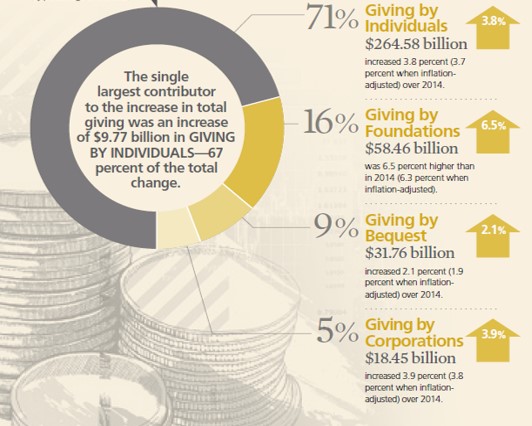Philanthropy
GUEST ARTICLE: When Politics And Philanthropy Intersect

A regular columnist for FWR does not pull any punches in analyzing the current direction of US tax policy as it affects philanthropic giving, and gives advice to wealthy donors on how to act.
The author of this item is Susan Winer, Chief Operating Officer and co-founder of Strategic Philanthropy, a firm headquartered in Chicago. Susan is a regular commentator for Family Wealth Report (see a previous article of hers here.) Her firm works solely with high net worth and ultra-high net worth donors, and was established in 2000. In a series of articles, she is setting out some of the most important issues in philanthropy and financial advice, not just for those in North America, but around the world. This news service does not necessarily endorse the views of guest contributors; nonetheless, the editors of this news service are delighted to share these insights and we hope they stimulate debate; readers who want to send in commentary and feedback should contact the editor at tom.burroughes@wealthbriefing.com
Politics and philanthropy are not often used in the same sentence, but these days, given the political landscape in the US it may well be time to change this paradigm.
Charitable deductions have been part of the US Tax Code since 1917, providing Americans, whatever their income level, an opportunity to be generous, resulting in a strong philanthropic safety net for NGOs around the world, while simultaneously mitigating taxes. Now, 100 years later, this “benefit” is being threatened.
Equal access to, and opportunity for, a good education, medical care, housing and human and civil rights are the bedrock of civilized nations. In many instances, philanthropic gifts have helped to protect these rights. Nevertheless, what is clear in 2017 is that “times they are a-changing”, to quote Simon and Garfunkel. The US political environment is demonstrably in chaos. It appears that, these days, no one is in charge and any proposed “reforms” directly, and negatively, target the neediest and most marginalized populations in the US and across the globe. Figuring out how to navigate a shifting landscape of possible regulatory and tax law is increasingly becoming impossible.
Just one example of the impact of proposed tax reforms relative to charitable giving has to do with allowable deductions. Trump is proposing a cap on total itemized deductions, including the charitable deduction, at $100,000 for single filers and $200,000 for joint filers. Currently individuals can deduct up to 50 per cent of gross income, benefitting for the most part the wealthier sector of society.
To put that into perspective, according to the Giving USA 2016 Annual Report on Philanthropy, in 2015 Americans gave more than $373 billion to charitable organizations to fund strong arts and culture organizations; increase access to education and healthcare; create opportunities for escaping the cycle of poverty; help military veterans; mentor youth; and protect the natural world. This was up from $358 billion in 2014. Seventy-one percent of that amount came from individuals.

To parse the findings further, a study conducted by Indiana
University’s Lilly Family School of Philanthropy, found that in
2015:
• Ninety-one percent of high net worth
households donated to charity, compared with 59 percent of the
general population of U.S. households donating; and
• On average, high net worth donors gave
$25,509 to charity in 2015. By comparison, general population
households gave $2,520 on average.
If Trump and Congress have their way, the tax plan proposed by Donald Trump would reduce individual giving by 4.5 per cent to 9 per cent, or between $13.5 billion and $26.1 billion, according to the Tax Policy Center. A subset of this figure relates to bequests, which account for 9 per cent of total giving. If the estate tax, in particular, is eliminated, testamentary gifts could be reduced by as much as 70 per cent.
The Congressional Budget Office estimates that any tax repeal would decrease donations to charity by 6 per cent to 12 per cent and United Way Worldwide has reported that nearly two-thirds of Americans might reduce giving by 25 per cent or more.
Two particular recipients of the aforementioned charitable dollars, education (12 per cent) and health care (8 per cent) are in the crosshairs of the current administration. Reduction in access, however that may be interpreted, will potentially negatively affect millions of people, creating long term and even lasting damage for multiple generations. And another downside - according to a coalition that includes United Way Worldwide, the Salvation Army, Catholic Charities USA, the Association of Fundraising Professionals, the Council on Foundations, and the Philanthropy Roundtable - is that one-in-10 Americans work in nonprofits. If funding drops, or ceases, both those jobs, and employment opportunities and community services created by the organizations would be threatened.
So what are the options? First, there are any number of opinions about timing. The consensus seems to be that should there be substantive changes in the tax law they would not take effect until 2018 or even later. Second, it is unrealistic to assume that private funds will replace the public funds needed to underwrite and deliver critical social services and continue to take a leadership role in protecting the health and well -being of world populations. However, that said, donors should consider the following, whether or not there are adverse tax changes that relate to charitable giving, but certainly as cautionary actions should there by tax law changes in 2018.
As their trusted advisor, you can offer clients some suggestions for anticipating changes in tax law while simultaneously helping them be even more thoughtful around their charitable giving.
Consider the following actions:
- Revisit the estate plan. When was the last time it was reviewed, and amended, if need be? Now with uncertainty surrounding estate taxes and gift deductions, estate plans should be looked at with both the tax and legacy lens in place. How does the client want to be remembered, what footprint does he or she want to leave for the next generations and for his or her community. Perhaps consider making a major gift during a client’s lifetime, which normally would have been testamentary, This would accomplish two things; provide tax benefits now and allow your client to reap the rewards of seeing, while they are still living, how his or her gift makes a difference;
- If there is an impending liquidity event, timing may be a critical factor if taxes are an issue. Is there a charitable giving plan in place that will mitigate any taxes or provide a favorable tax deferment? This should be discussed and a plan in place prior to the liquidity event;
- If your client is unsure of which charities to support, or how, consider depositing as much of the funds that are available in a Donor Advised Fund. This is a way to receive an immediate tax deduction even though the funds will not be disbursed until a later time;
- Rather than waiting until the end of December to make charitable gifts consider starting earlier in the year. In this way, your client can have deeper conversations with organizations being considered for a gift. This will make the gift both more meaningful and ensure there is a clear understanding of how the gift is to be used;
- Think about funding general operating expenses rather that strictly programmatic funding. Helping organizations keep the lights on and hire appropriate staff is important, particularly if they need to budget forward in the event of losses in funding;
- Look at ways to use more of a client’s assets to provide support in key social, environmental, human rights or globally related issues. Aligning their investment portfolio with their personal or philanthropic mission and interests can achieve a double bottom line return - financial and social. This is particularly true if the client has a foundation or Donor Advised Fund or Trust through which they are giving to charitable causes; and
- If the intention is to leave a large gift to a private foundation through the estate, then consider including a contingent alternative bequest to a public charity. In this case, the estate tax deduction potentially would not be limited.
The most important thing to keep in mind is the value of the conversation about proposed changes in tax law, the implications and impact of those changes on your client. Your clients are expecting you to findi creative ways to help them achieve their financial, estate and philanthropic goals. You’ll find that just initating the conversation will help reduce stress for your clients and deepen the relationship you have with them.
